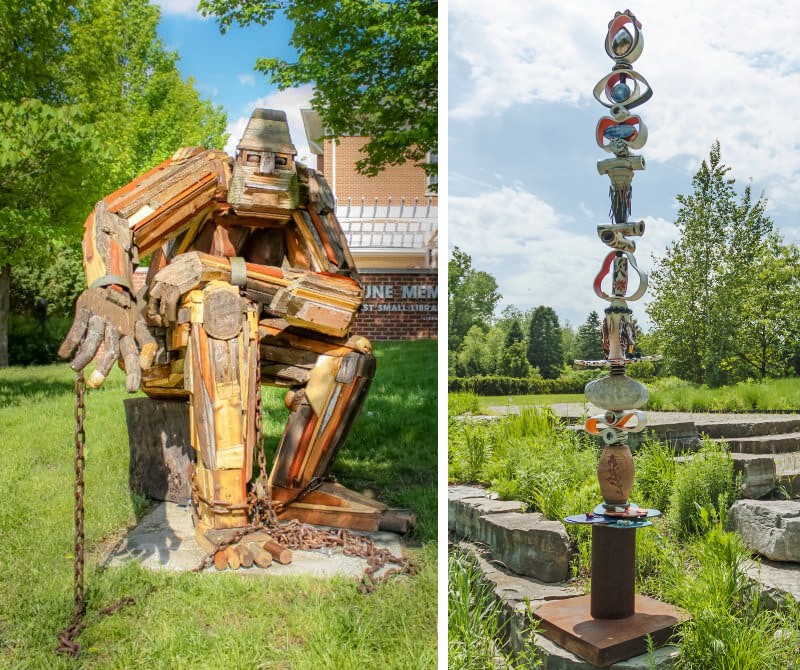Factsheets, Funny Folks & Freaks: Christopher Becker recalls his DIY days in the '80s and '90s zine scene

This essay is related to the Ann Arbor District Library exhibition "'Sorry This Issue Is Late...': A Retrospective of Zines From the '80s and '90s," written by curator Christopher Becker, former editor of Factsheet Five and now a library technician at AADL.
Let me start at the end.
I was living in San Francisco in one small room of a shared apartment. Piles and piles of zines—self-made, usually photocopied publications—surrounded my bed and computer so that they were the first and last thing I looked at every day.
And every day there were more, threatening to spill into the narrow walkway I had created in the room.
I worked at Factsheet Five, a magazine that printed reviews and contact information for over 1000 zines every issue, and a year earlier I had taken over the day-to-day operations of the magazine and moved it to my bedroom.
In the mornings, I rode my bike to the post office to pick up the mail, sometimes up to 50 pounds. Through a combination of multiple messenger bags, panniers, and bungee cords, I brought the mail back, looking like an overburdened caricature of a tuktuk driver from Thailand. All the mail—the zines, so many zines, the letters, the issue requests and subscriptions, the packages of books and CDs, had to be sorted and then the day’s work began: reviewing.
It was a dream come true to work at Factsheet Five and I’m sure I’ll never have such a rare experience again in my life. It felt thrilling and important to be at the heart of so much creativity and live vicariously through all the lives of the zine publishers.
But lately, staying on top of the flood of zines and the reviews was overwhelming and I was exhausted.
I began to understand why Mike Gunderloy had left the magazine he had founded, why Hudson Luce had only published one issue after he got it, and why R. Seth Friedman, who then took over, had handed the daily operations to me after several years.
U-M prof Jeffrey Veidlinger on his book "In the Midst of Civilized Europe: The Pogroms of 1918-1921 and the Onset of the Holocaust"

Jeffrey Veidlinger, a celebrated historian and Joseph Brodsky Collegiate Professor of History and Judaic Studies at the University of Michigan, scoured trial records, official documents, and witness statements to assemble his new book, In the Midst of Civilized Europe: The Pogroms of 1918-1921 and the Onset of the Holocaust, which recounts organized violence against Jewish people in the Ukraine and Poland before World War II.
“For about 10 years, I was a co-director of The Archives of Historical and Ethnographic Yiddish Memories, which involved conducting Yiddish language oral history interviews with elderly folks in Ukraine," he said. "During those interviews, I was struck by people's experiences and memories of the pogroms of 1918-1921 and by the similarities in the ways in which they describe the pogroms and the Holocaust. The interviews impelled me to go back to the revolutionary period and to look more closely at exactly what happened.”
Veidlinger will appear via Zoom to discuss his work at the 34th annual Ann Arbor Jewish Book Festival on November 30 at 7 pm.
U-M's production of Shakespeare’s "A Midsummer Night’s Dream" is all about the love—and the laughs

William Shakespeare’s A Midsummer Night’s Dream is one of the Bard’s most popular comedies and one of the most accessible for modern audiences.
And why not?
It has a little bit of everything for everybody.
There’s 16th-century style rom-com, fairies with magic spells and love potions, and a hilarious troupe of amateur thespians who are preparing a show for a royal wedding.
The University of Michigan Department of Musical Theatre will present a production of A Midsummer Night’s Dream Dec. 2-5 in the Arthur Miller Theater, directed by Vincent Cardinal.
“Why I think it’s popular is that at its core it’s about love and about our impulses to find love and to find people to love and how complicated that is and how it works in the larger structure of our society as well as our personal lives,” Cardinal said. “So it’s examining issues that are core to what it is to be a human being.”
U-M mines Ayad Akhtar's "Junk: The Golden Age of Debt" and the impact of the 1980s bonds scandal

In Oliver Stone’s movie Wall Street, investor Gordon Gekko sums up what capitalism is all about from his point of view: “Greed is good.”
Playwright Ayad Akhtar takes a more nuanced look at American finance in his play Junk: The Golden Age of Debt, a play about the increased investment in high-yield bonds—or junk bonds. Akhtar’s play is loosely based on the rise and fall of financier Michael Milken. In the 1980s, Milken changed Wall Street with his embrace of junk bonds, the idea that “debt is an asset,” and his acquisition of debt-troubled corporations.
In 1990 Milken pleaded guilty to six counts of securities and tax violations. He paid heavy fines and served a greatly reduced 22-month prison sentence. He went on to become a philanthropist, especially noted for his contributions to medical research. In February, outgoing President Donald Trump pardoned Milken.
The University of Michigan Department of Theatre and Drama will present Ayad Akhtar’s Junk Dec. 2-5 at the Power Center, directed by Geoff Packard.
When searching around for a play to direct that would engage University of Michigan theater students and audiences, Packard chose Akhtar’s play for its provocative ideas but also for practical reasons.
The pandemic has had a big impact on the theater program with canceled performances and contact restrictions that have resulted in fewer performance opportunities for students,
“I was told to book a big play that would fill the Power Center,” Packard said. “So the first place I went was to a directory of all the plays that were done at [New York City’s] Vivian Beaumont since this is a similar footprint to the Power Center.”
The Brave and the Bold: U-M’s "Men on Boats" injects a historic expedition with a fresh perspective

In 1869, John Wesley Powell led a 10-man expedition to map and gather information on a large swath of the American West, from Wyoming to the Grand Canyon along the Green and Colorado rivers. Powell was a geologist, naturalist, anthropologist, and veteran officer of the Civil War.
Playwright Jaclyn Backhaus takes a satiric look at this famous manly journey into the unknown by casting her play Men on Boats with 10 women.
Emily Lyon, a 2013 graduate of the University of Michigan, is directing a “non-man” cast in a U-M Department of Theatre and Drama presentation of Men on Boats, Nov. 11-14, at the Arthur Miller Theatre.
Lyon said she was intrigued by Backhaus’ idea of having women fill those positions that history had filled with men. She said she wants to fill that space and have her cast “become explorers and adventurers and stepping into that sense of bravado, letting 10 young women and non-binary actors own the stage in the way that men in the 1800s felt that they owned the land is a fun and bold project.”
The Rasa Festival shifts formats for its 2021 celebration of Indian arts
Ann Arbor's Rasa Festival, which celebrates Indian dance, music, theater, film, and poetry, moved online during the quarantine. Generally speaking, it kept the format of the previous years' festivals just with scheduled live streams during the length of the festival rather than in-person events.
For the 2021 edition, Rasa will still be entirely online, but rather than presenting a series of livestreams in a compacted time period, the festival will produce event videos about once a month for the next six to eight months.
The Ann Arbor District Library is a partner for this year's Rasa Festival, which kicks off with Songs of Dusk on AADL.tv on Saturday, October 23, at 11 a.m.
Songs of Dusk features five dances choreographed to songs featuring the lyrics of poet Batakrishna Dey, the father of Rasa founder Sreyashi Dey.
The dancers are the styles of dances there are doing include:
AADL Black Lives Matter: Mural Dedication

On Friday, July 23, at 7 pm, join the Ann Arbor District Library for the dedication of the Black Lives Matter Mural newly installed on Library Lane.
This mural showcases the work of eight Black artists who show what the phrase Black Lives Matter means to them. This project was commissioned by the Ann Arbor District Library in the summer of 2020 as part of its Call for Artists.
Two new outdoor sculpture exhibits offer public art in Washtenaw County

Right: Sculpture tower by Jen Gerrity, Sherry Hall, Ben Mattison, Daria Paik, and Jin Young Yeum at Matthaei Botanical Gardens. Photo by Jeri Hollister.
Even with everything starting to open up again—including the University of Michigan Museum of Art—you may understandably still feel a little weird about spending time indoors with other people. But two new outdoor sculpture exhibitions offer the delights of visual art alongside maximum air circulation.
University of Michigan School of Music, Theatre & Dance announces 2021-2022 productions

Drama is back at the University of Michigan.
No, I'm not talking about any political, criminal, or social issues.
The University of Michigan School of Music, Theatre & Dance (UMSMTD) announced 10 performances and one studio production as part of its 2021-22 production season, which runs from September 30 to April 17.
“Our goal this year is to return to creating the same high-quality productions you’ve come to know and love while providing more flexibility to better accommodate our audiences’ health and safety needs,” said Jeffrey Kuras, executive director of the school’s University Productions, in a press release.
Some of the other annual performances—Grand Night for Singing, Halloween Concert, Band-O-Rama, and Collage Concert—will be announced at a later date. Tickets for all the events will eventually be available at tickets.smtd.umich.edu.
"The SMTD Flex Series will allow audiences to select the four shows they would like to attend at a discounted price," according to the UMSMTD press release. "The Flex Series joins the existing Power Series, which allows audiences to purchase all four shows at the Power Center for the Performing Arts for a discounted price." (The Power Center turns 50 this year.)
Here's a rundown of UMSMTD's 2020-2021 season events:
Looking Forward & Back: Ann Arbor Art Fair returns in 2021 after a year's absence

Last year was supposed to be the 60th annual Ann Arbor Art Fair, but it was canceled because of the pandemic. It looked like the 2021 edition wasn't going to happen either, and it was even officially called off for a while, but once it looked like Michigan would start opening up again for the summer, the Art Fair was reinstated and takes place July 15-17.
By this point, you know the drill with Art Fair: parking is difficult, you love or hate the crowded streets, it's usually hot and muggy. But if you need a quick guide to parking and a map of the 2021 event, MLive has a brief article with both.
And if you're wondering what goes into Art Fair prep for the creatives, landscape painter Karin Wager Coron talked to WEMU's David Fair about her routine.
But if you're wondering a bit about the history of the Art Fair, in 2009 the Ann Arbor District Library's archives team put together a wonderful collection of photos, posters, and more on the occasion of the event's 50th anniversary of its conception—conceived in 1959, launched July 20-22, 1960:


































